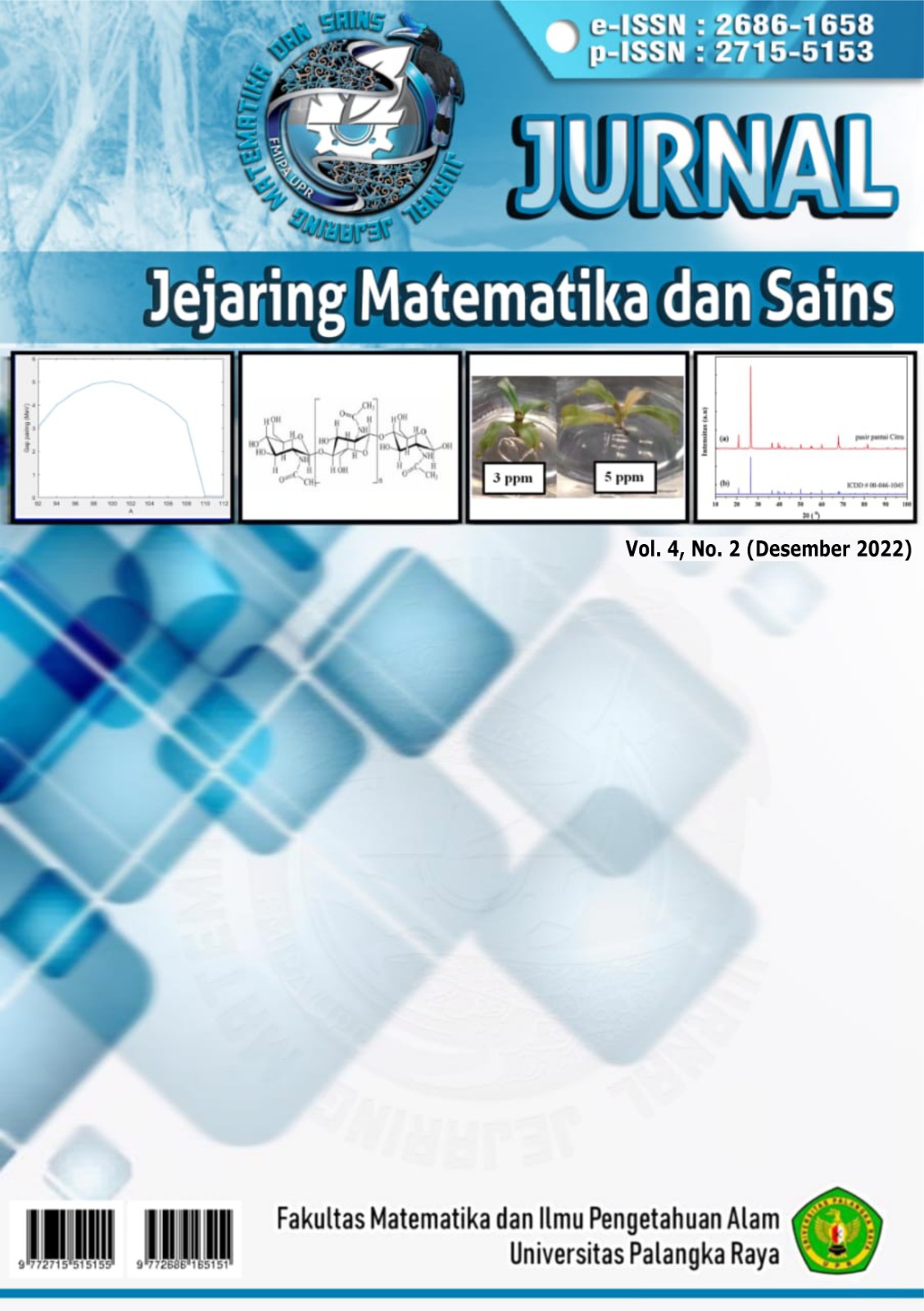Molecular Docking Senyawa α-mangostin sebagai Antiinflamasi secara In Silico
DOI:
https://doi.org/10.36873/jjms.2022.v4.i2.707Keywords:
α-mangostin, ICE, inflammation, in silico, molecular dockingAbstract
Inflammation is the body's physiological response to infection and tissue injury. Inflammatory mediators, especially cytokines such as tumor necrosis factor-alpha (TNF-α), interleukin-1 beta (IL-1β), and interleukin-6 (IL-6) are cytokines involved in acute inflammation. Inflammation can occur when these inflammatory mediators interact with each other. α-mangostin is one of the xanthone that found in the pericarp of mangosteen which has anti-inflammatory activity. The aim of this study was to determine the mechanism of inhibition of ICE protein by α-mangostin in silico with molecular docking. Molecular docking in silico was carried out in several stages, such as preparation and optimization of the 3D structure of α-mangostin, preparation of the target protein, validation of the molecular docking method, and docking of α-mangostin compounds on ICE which refers to the parameters of the bond energy and the type of bond formed. If the bond energy value between the test compound and the target protein is lower, the bonds formed will be stronger and more stable. The results of molecular docking of α-mangostin to ICE protein is the between α-mangostin to ICE protein with a binding energy is about -4,29 kkal/mol. The negative binding energy indicates that α-mangostin has anti-inflammatory activity with an ICE inhibitory mechanism.
Downloads
References
P.C. Calder, R. Albers, J. M. Antoine, S. Blum, R. Bourdet-Sicard, G. A. Ferns, and M. Løvik, “Inflammatory disease processes and interactions with nutrition,” British Journal of Nutrition, vol. 101, pp. 1-45, 2009.
A. N. Hasanah, F. Nazaruddin, E. Febriana, dan A. Zuhrotun, “Analisis kandungan minyak atisiri dan uji aktivitas antiinflamasi ekstrak rimpang kencur (Kampferin galangal L.),” Jurnal Matematika & Sains, vol. 16, no. 3, pp. 147-152, Desember 2011.
L. Ferrero-miliani, O. Nielsen, P. Anderson, and S. Girardin, “Cronic inflammation: importance to NOD2 and NALP3 in interleukin-1β generation,” Clinical & Experimental Immunology, vol. 147, pp. 227-235, 2007.
P. Conti, G. Ronconi, A. L. Caraffa, C. E. Galengga, R. Ross, L. Frydas, and S. K. Kritas, “Induction of pro-inflammatory cytokines (IL-1 and IL-6) and lung inflammation by Coronavirus-19 (COVI-19 or SARS-CoV-2): anti-inflammatory strategies,” J Biol Regul Homeost Agents,” vol. 34, pp. 327-331, 2020.
D. Blanco-Melo, B. E. Nilsson-Payant, W. C. Liu, S. Uhl, D. Hoagland, R. Moller, and T. T. Wang, et al., “Imbalanced host response to SARS-CoV-2 drives development of COVID-19,“ Cell, vol. 181, pp. 1036-1045, 2020.
S. Zhou, G. Wang, and W. Zhang, “Effect of TLR4/MyD88 signaling pathway on sepsis-associated acute respiratory distress syndrome in rats, via regulation of macrophage activation and inflammatory response,” Exp Ther Med, vol. 15, pp. 3376-8, 2018.
Y. Zhou, B. Fu, X. Zheng, D. Wang, C. Zhao, Y. Qi, H. Wei, et al., “Aberrant pathogenic GM-CSF+ T cells and inflammatory CD14+ CD16+ monocytes in severe pulmonary syndrome patients of a new coronavirus,” BioRxi, 2020.
H. Liu, K. Zhou, L. Liao, T. Zhang, M. Yang, and C. Sun, “Lipoxin A4 receptor agonist BML-111 induces autophagy in alveolar macrophages and protects from acute lung injury by activating MAPK signaling,” Respiratory Research, vol. 19, pp. 1-11, 2018.
F. Gutierrez-Orozco, C. Chitchumroonchokchai, G. B. Lesinski, S. Suksamrarn, and M. L. Failla, “α-mangostin: Anti-inflammatory activity and metabolism by human cell,” Journal of Agricultural and Food Chemistry, vol. 61, pp. 3891-3900, 2013.
R. I. Parmita, M. I. Ilmiawan, dan I. Armyanti, “Uji efek antiinflamasi kombinasi astaxanthin dan ekstrak kulit manggis (Garcinia mangostana Linn) pada tikus putih galur wistar,” Jurnal Cerebellum, vol. 3, no. 1, pp. 689-696, Februari 2017.
A. N. Jain and A. Nicholls, “Recommendations for evaluation of computational methods,” Journal of Computer-Aided Molecular Design, vol. 22, pp. 133-139, 2008.
B. Mukesh and K. Rakesh, “Molecular Docking: a Review,” International Journal of Research in Ayurveda and Pharmacy, vol. 2, pp. 1746-1751, 2011.
Hypercube, Hyperchem Release 7: Tools for Molecular Modelling, Canada: Hypercube Incorporation, 2002.
L. Franchi, T. Eigenbrod, R. Muñoz-Planillo, and G. Nuñez, “The inflammasome: a caspase-1-activation platform that regulates immune responses and disease pathogenesis,” Nature Immunology, vol. 10, pp. 241-247, 2009.
P. Prior and G.S. Salvesen, “The protein structures that shape caspase activity, specificity, activation and inhibition,” Biochemical Journal, vol. 384, pp. 2021-232, 2004.
R. Huey, G. M. Morris, and S. Forli, Using AutoDock 4 and AutoDock Vina with AutoDockTools: A Tutorial, California: Scripps Research Institute, 2012.
G. M. Morris, R. Huey, W. Lindstrom, M. F. Sanner, R. K. Belew, D. S. Goodsell, et al., “AutoDock4 and AutoDockTools4: Automated Docking with Selective Receptor Flexibility,” Journal of Computational Chemistry, vol. 30, pp. 2785-1791, 2009.
N. W. Diyah, Siswandono, S. Hardjono, dan B. T. Purwanto, “Pemodelan Molekul dan Hubungan Kuantitatif Struktur-Aktivitas Sitotoksik Turunan Benzoilurea sebagai Antitumor,” Berkala Ilmiah Kimia Farmasi, vol. 2, 2013.
S. Mohan, S. Syam, S. I. Abdelwahab, and N. Thangavel, “Anti-inflammatory molecular mechanism of action of α-Mangostin, the major xanthone from the pericarp of Garcinia mangostana; an in silico, in vitro and in vivo approach,” Food & Function, vol. 9, no. 7, pp. 3860-3871, Juli 2018.

Downloads
Published
How to Cite
Issue
Section
License
Copyright (c) 2023 Jurnal Jejaring Matematika dan Sains

This work is licensed under a Creative Commons Attribution-NonCommercial-ShareAlike 4.0 International License.
















